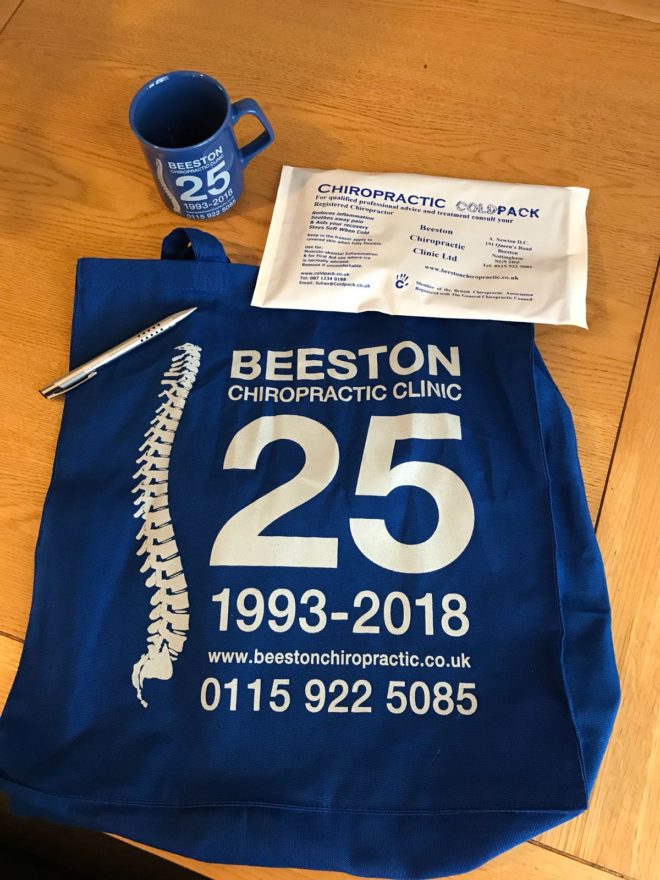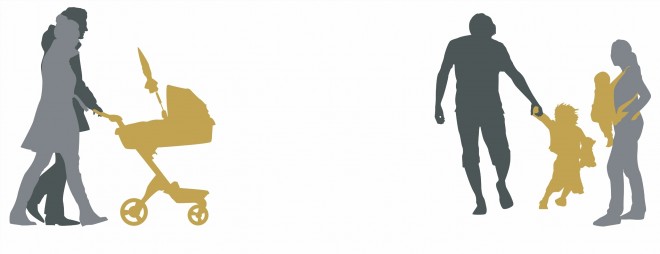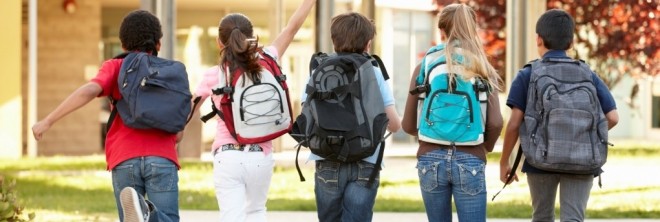
It\'s all about the babies!
As we congratulate Jenny and Mark on the safe arrival of little Georgina Doris and get rudely thrown back into the routine of school and work after what can only be described as a proper summer season, let's think about posture and be more mindful about what we are doing to ourselves on a daily basis. Don't get into bad habits, keep yourself fit, active and eat well.
Your target is to ensure you maintain that work life balance. The days are getting shorter, a minute every three days and this will make you less likely to want to exercise after work, so try and set more time aside at the weekend to keep your exercise routine going. Remember the hardest thing is to get out there - once you're there its well worth it and you can feel proud of yourself.
Look out for your September Challenge around the clinic.
Thank you for everyone who completed the patient satisfaction questionnaire, we have six lucky winners for the Prosseco and 25th Anniversry bags and they all have been contacted now. Analysis of the results and conclusions will take place over the next few weeks and we will publish these in due course.
This month we are going to focus on pregnancy and parental posture for those of your who are new to parenting or even being a grandparent - check out our advice to help you enjoy every moment of those little lives.
We still have a few 25 year bags left so if you haven't got yours please ask at reception - proceeds go to the up keep of the community defibirllator.

How To Manage Back Pain During Pregnancy
One of the most common side effects of pregnancy for women across the country is back pain, especially lower back pain.
Your body goes through lots of changes when you’re pregnant, including gaining extra weight, your centre of gravity becoming lower and the ligaments around your pelvis are relaxing to prepare you for labour.
Did you know.. Although exercise may not seem appealing it can be a very effective at helping to ease the pain.
Gentle exercise that helps strengthen the core abdominal muscles can help to spread the weight around your body and prevent localised pain in your lower back.
Keeping your muscles active can help prevent them becoming stiff and painful as your pregnancy develops.
Remember.. Posture is also key to relieving back pain during pregnancy.
Always remember these principles of good posture to help relieve any stress on your spine:
- Stand up straight rather than slouching
- Hold your chest high
- Keep your shoulders and back relaxed
- Stand with your feet hip width apart to keep your upper body fully supported
It is also good to support yourself, whether you’re exercising or simply lying down, to help your body cope with the extra weight it is carrying.
Did you know… Water based exercises, such as aqua natal classes, are a particularly effective way to exercise the muscles during pregnancy without over exerting yourself as the buoyancy of the water can also act as an extra support for your body.
Gentle yoga or going for a walk are other good ways to keep the muscles active and help ease the symptoms of backache during pregnancy.

Prevent the Pain in Parenthood
One of the most likely times men and women get back pain is when there is an infant in the house needing to be picked up and carried. Both these times are paradoxically when you would like your back to be functioning at it’s best.
Caring for an infant puts stress on your back. Initially, you may be lifting the 7 to 10 pound baby up to 20-30 times a day. By the time the child is a year old, you are lifting and carrying around 17 pounds. Two years later, you will be lifting a 25 to 30 pound child.
Here are some ways that new mothers, fathers and grandparents can help reduce their risk of injury and back pain.
Safe lifting, the basics: Stand with your feet at least a foot apart, this will give you a stable base of support. Keep your back as straight as possible and bend your knees. Do not stretch your arms out straight to pick up the baby. Bring the baby close to your chest before lifting.
Lift using both arms and your thigh muscles, which are amongst the largest and strongest muscles in the body. To pick up a child from the floor, bend at your knees-not at your waist. Squat down, tighten your stomach muscles and lift with your legs. When carrying and moving a child, pivot with your feet until you are facing your destination then lower the child into the crib or onto the floor by bending at the knees, with a straight back.
Carrying: Hold your child in an upright position, directly against your chest. Carrying a child on one hip creates postural imbalances that can lead to low back pain over time. Consider using a ‘front pack’ to carry the baby when you are walking.
Exercise for women: Begin exercising again soon after delivery to restore muscle tone to the abdominal and back muscles. While the baby is napping, take 10 minutes to do stretching exercises on the floor or bed each day. This will help restore hip and back flexibility. Try to return to your normal weight within six weeks after giving birth. If you had a Caesarean-section (C-section) delivery, wait six weeks or until you get the permission of your obstetrician or GP before you begin exercising.
Breast feeding: To avoid upper back pain from breastfeeding, bring the baby to your breast, rather than bending over the baby. While you are nursing, sit in an upright chair rather than a soft couch or ask your chiropractor about biological feeding – this is a better and more effective posture for you and your baby.

Healthy Postural Positions for Babies
Birth is one of the most traumatic experiences a baby can go through. It is not often known, for example, that the baby’s cranial bones move and overlap affording the flexibility required during delivery. Even after a successful delivery, a baby’s spine is still at risk.
However, there are some precautions you can take as a parent to minimize this risk both to your baby and to yourselves. Here are the healthiest positions for you to care for your baby.
Holding baby: your baby should be held close to you with the back of your baby’s head supported with your index finger behind the ear.
Bathing baby: your baby’s head should be supported using your thumb and forefinger while your free hand is used for bathing and supporting your baby in the tub.
Parent/child interaction: throwing your child up and down can actually cause spinal problems due to a lack of support as your child is being bent forward and backwards.
Picking children up: when lifting your child, you should be on your haunches, lift your child while holding them under both arms, and avoid carrying them on one hip. Preferably, your child should be carried in front of you with one leg either side of you.
Papoose type slings and carriers: unfortunately contraptions that allow your child to sit before it is naturally able to can cause major spinal problems. Most of the holding devices keep your baby’s spine in the ‘c’ shape curve it’s born with and do not allow the normal curves in the neck and low back to develop.
Dressing the child: clothing that has a tight collar can put a strain on your child’s spine in the neck and the area between the shoulder blades. Buttons and zips should be used as much as possible.
Feeding: if breast feeding, you should hold the baby at the level of the breast whilst supporting your arm on a pillow, to reduce spinal problems in yourself. You should place the baby so that it faces your breast so that rotation of your baby’s neck is minimized or aim for the biological nurturing position.
Crawling: crawling should be actively encouraged, as a lack of sufficient crawling is responsible for weak spinal architecture. If your baby resists lying on their tummy during this time it may be an indication of a spinal problem that should be assessed by your chiropractor.
Emotional stress can also affect your baby. Domestic disharmony and maternal distress is very quickly picked up by the infant and translated into irritability, crying and unsettled behaviour. The negative effect on muscle tone, sleeping and feeding patterns is a major contributor to spinal subluxations.
As parents, bonding should be encouraged immediately for you both. Holding the infant close to your body, maintaining sustained eye contact, smiling and making soothing sounds are all important.

Dangers of Back Pain at School
The new school year has just started. Children are back in the classrooms, will be running around playgrounds and playing sports. However, children, like adults, can be prone to back pain, and there can be several causes.
The most common causes of joint and back pain in school children are:
- Lack of exercise or excessive exercise
- Weight of school bags
- Bad posture
- Poorly set up desks
- Use of a computer or computer games
- Sports injuries
- Ill-fitting shoes/improper shoes
Lack of exercise and excessive exercise
The general finding from various studies is that children involved in competitive sports and those who are sedentary are more prone to getting low back pain while those that participated in moderate activity were protected. The children involved in competitive sports run the risk of getting repetitive strain injuries. Those children who are sedentary are often those who sit and watch a lot of television or play on computer games. The implication of this will be discussed below.
Weight of school bags
School bags are exceptionally heavy for those attending secondary school due to the number of different subjects covered and therefore the number of textbooks required and the fact the children often have to move between classes. Not all children have access to lockers, which mean that books have to be carried with them. Bags carried on one shoulder causes an asymmetry of the body and therefore certain muscles will have to tighten and others lengthen in order to carry the bag. These kinds of imbalances can cause long-term problems.
Bad posture
All aspects of life can induce bad posture; lack of exercise, weight of school bags, spending too much time playing computer games or on the computer, incorrect shoes, and growth. Those children who grow faster and become taller than their peers may slouch in order to not tower above their friends and this can ultimately lead to bad posture.
Poorly set up desks
Whether at school or home, ill-fitting desks can lead to bad posture. School desks and chairs cannot cater for individual heights of children and, as mentioned earlier, the children often have to move between classes. The desks and chairs are uniform and unable to be altered to the child’s individual needs. Guidance on correct desk set up should be implemented at home; not just for the kids but also for everyone in the family who uses the desk. At school this can’t be done, but by advising the child to sit upright and not to slouch and not to cross the legs will help.
Use of a computer or computer games
Anybody position requires certain muscles to shorten and others to lengthen. This occurs every time we move. If we were to stay in one position for too long those muscles will eventually stay that particular length. When children play on computer games it quite often requires time. This leads to the above situation with muscles. Children should be encouraged to not spend longer than 30-40 minutes at any one time playing games, using a computer, or even doing homework before having a break. The child should spend a few minutes walking around and then returning to the game/homework by reviewing their posture and sitting correctly.
Sports injuries
Those children who play a lot of sport and those who play contact sports such as rugby may be injured either by direct contact or by overuse of certain muscles. If a child is injured it is advisable that they are seen by a chiropractor as problems unresolved can lead to compensations, i.e. walking differently due to sprained ankle leading to low back pain, a rugby tackle causing neck pain and headaches.
Ill-fitting shoes/improper shoes
Children are conscious of fashion, which can affect their shoe wear. Girls particularly may wear shoes with a high heel. This causes the calf muscles to shorten and pushes the body forward. To prevent falling over the girl would have to lean back and causing an increase in the low back curvature which can not only cause low back pain but also pain between the shoulder blades.
Wearing improperly fitting shoes can cause many problems from blisters, pressure sores and ingrowing toenails in the short-term, to feet deformities like hammer toe, and knee and posture problems in the long-term. It can take up to 18 years for feet to fully develop, so teenager’s feet need to be looked after just as much as younger children’s.
Shoes should be the correct size and offer the right amount of support. When purchasing new shoes, get the child’s feet correctly sized by the shop assistant and ensure that the shoes are the correct length as well as width.
Here’s some advice to help your child:
- Rucksacks should be worn across both shoulders and the straps adjusted so the bag is held close to the body.
- If a locker is available, encourage your child to use it and ensure they only take the books and equipment needed for that day.
- Check their shoes are correctly fitted, supported, relatively flat, and are not too worn.
- Encourage your child to enjoy regular exercise, such as swimming and cycling.
- Use of the computer, playing computer games and homework should be in blocks of no more than 30-40 minutes. Advise them to have a little walk before returning and again that they sit with their shoulders down and back (not slumped) and their legs are uncrossed.
- See a chiropractor if your child is experiencing pain or discomfort, or even just to get a check-up.
We treat all conditions that affect any muscle or joint in your body, from your head to your little toe! One of the most common complaints that we treat is back pain and Chiropractic is recommended by the government authority, the National Institute for Clinical Excellence (NICE) for acute and chronic back pain. Some of the other conditions that we treat are neck and headache, shoulder pain, leg and hip pain, knee and foot pain, sciatica and arthritis. Our registered Chiropractors all have at least five years of training. Treatment costs can be covered through most health insurers. If you are in any doubt, we are always very happy to talk with you on the phone to see if your condition will respond well to Chiropractic treatment. Call the clinic now to arrange an appointment time that works for you. 0115 9225085 If you would like to opt-out of receiving these newsletters please follow the unsubscribe link below, email alex@beestonchiropractic.co.uk or let us know at your next appointment.





